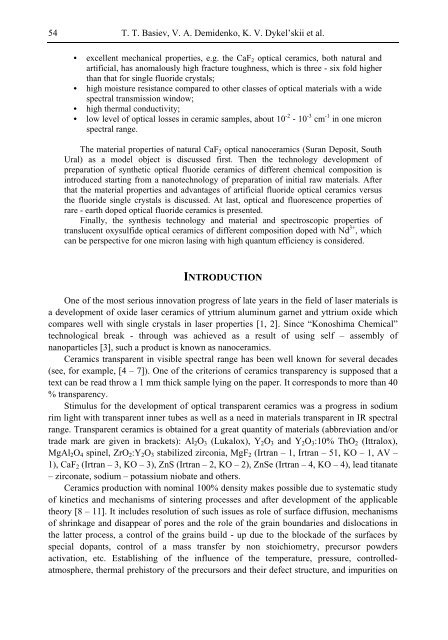Developments in Ceramic Materials Research
Developments in Ceramic Materials Research
Developments in Ceramic Materials Research
Create successful ePaper yourself
Turn your PDF publications into a flip-book with our unique Google optimized e-Paper software.
54<br />
T. T. Basiev, V. A. Demidenko, K. V. Dykel’skii et al.<br />
• excellent mechanical properties, e.g. the CaF2 optical ceramics, both natural and<br />
artificial, has anomalously high fracture toughness, which is three - six fold higher<br />
than that for s<strong>in</strong>gle fluoride crystals;<br />
• high moisture resistance compared to other classes of optical materials with a wide<br />
spectral transmission w<strong>in</strong>dow;<br />
• high thermal conductivity;<br />
• low level of optical losses <strong>in</strong> ceramic samples, about 10 -2 - 10 -3 cm -1 <strong>in</strong> one micron<br />
spectral range.<br />
The material properties of natural CaF2 optical nanoceramics (Suran Deposit, South<br />
Ural) as a model object is discussed first. Then the technology development of<br />
preparation of synthetic optical fluoride ceramics of different chemical composition is<br />
<strong>in</strong>troduced start<strong>in</strong>g from a nanotechnology of preparation of <strong>in</strong>itial raw materials. After<br />
that the material properties and advantages of artificial fluoride optical ceramics versus<br />
the fluoride s<strong>in</strong>gle crystals is discussed. At last, optical and fluorescence properties of<br />
rare - earth doped optical fluoride ceramics is presented.<br />
F<strong>in</strong>ally, the synthesis technology and material and spectroscopic properties of<br />
translucent oxysulfide optical ceramics of different composition doped with Nd 3+ , which<br />
can be perspective for one micron las<strong>in</strong>g with high quantum efficiency is considered.<br />
INTRODUCTION<br />
One of the most serious <strong>in</strong>novation progress of late years <strong>in</strong> the field of laser materials is<br />
a development of oxide laser ceramics of yttrium alum<strong>in</strong>um garnet and yttrium oxide which<br />
compares well with s<strong>in</strong>gle crystals <strong>in</strong> laser properties [1, 2]. S<strong>in</strong>ce “Konoshima Chemical”<br />
technological break - through was achieved as a result of us<strong>in</strong>g self – assembly of<br />
nanoparticles [3], such a product is known as nanoceramics.<br />
<strong>Ceramic</strong>s transparent <strong>in</strong> visible spectral range has been well known for several decades<br />
(see, for example, [4 – 7]). One of the criterions of ceramics transparency is supposed that a<br />
text can be read throw a 1 mm thick sample ly<strong>in</strong>g on the paper. It corresponds to more than 40<br />
% transparency.<br />
Stimulus for the development of optical transparent ceramics was a progress <strong>in</strong> sodium<br />
rim light with transparent <strong>in</strong>ner tubes as well as a need <strong>in</strong> materials transparent <strong>in</strong> IR spectral<br />
range. Transparent ceramics is obta<strong>in</strong>ed for a great quantity of materials (abbreviation and/or<br />
trade mark are given <strong>in</strong> brackets): Al2O3 (Lukalox), Y2O3 and Y2O3:10% ThO2 (Ittralox),<br />
MgAl2O4 sp<strong>in</strong>el, ZrO2:Y2O3 stabilized zirconia, MgF2 (Irtran – 1, Irtran – 51, KO – 1, AV –<br />
1), CaF2 (Irtran – 3, KO – 3), ZnS (Irtran – 2, KO – 2), ZnSe (Irtran – 4, KO – 4), lead titanate<br />
– zirconate, sodium – potassium niobate and others.<br />
<strong>Ceramic</strong>s production with nom<strong>in</strong>al 100% density makes possible due to systematic study<br />
of k<strong>in</strong>etics and mechanisms of s<strong>in</strong>ter<strong>in</strong>g processes and after development of the applicable<br />
theory [8 – 11]. It <strong>in</strong>cludes resolution of such issues as role of surface diffusion, mechanisms<br />
of shr<strong>in</strong>kage and disappear of pores and the role of the gra<strong>in</strong> boundaries and dislocations <strong>in</strong><br />
the latter process, a control of the gra<strong>in</strong>s build - up due to the blockade of the surfaces by<br />
special dopants, control of a mass transfer by non stoichiometry, precursor powders<br />
activation, etc. Establish<strong>in</strong>g of the <strong>in</strong>fluence of the temperature, pressure, controlledatmosphere,<br />
thermal prehistory of the precursors and their defect structure, and impurities on
















